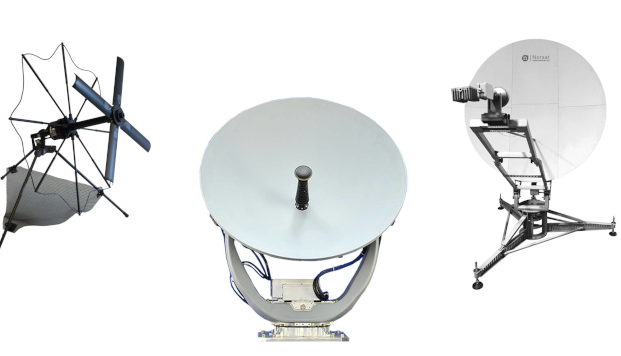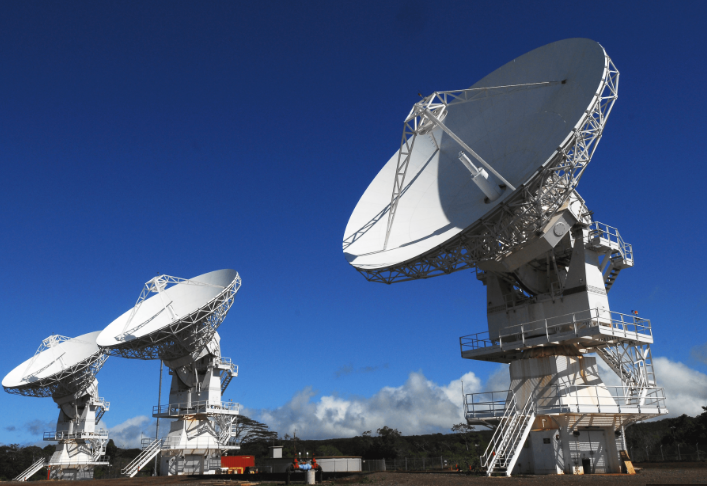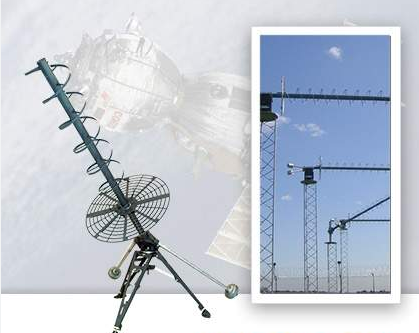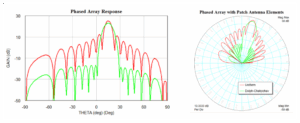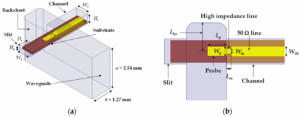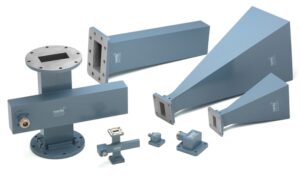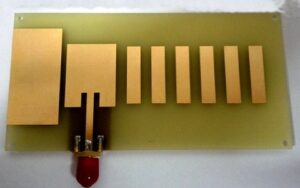Explore various Satcom antennas like parabolic dishes, phased arrays, and helical antennas for efficient satellite communication.
Table of Contents
Parabolic Dish Antennas
Background: Describe the key features of your technology, how it works
and what it is used for
Parabolic Dish Antennas are an important element of satellite communication systems, recognized mainly for their capability to focus signals in a very narrow beam. Generally, this type of antenna includes parabolic reflector and a feed antenna near its focus. When it is transmitting, radio waves from the feed radiation into space, and when receiving, the radio waves from the space are all focused onto the feed . Being designed in this way, Parabolic Dish Antennas ensures high gain, thus boosting the signal strength and increasing the communication range. As for the parabolic dish antennae that can be typically seen at consumer’s home, they have the gain of about 35-40 dB or more . Dishe’s curvature is specific, thus helping to focus the signal to be transmitted, which is central from the point of view of preserving the quality of the link.
Applications in Satcom: Describe where your technology is used and why
Parabolic Dish Antennas are essential for numerous applications, including but not limited to Direct-to-Home TV broadcasting , Telecommunications through various types of satellites, Deep space radio communication supporting missions to different planets of the solar systems, and Internet via Satellite for many remote areas. This type of antenna can be used with geomobile communication satellites, but it is also required in the framework of fixed service by geostationary satellites. Parabolic Dish Antennae are very efficient in terms of dealing with high-power signals.
Cost and Installation: Describe the cost and installation requirements for
your technology
The cost of Parabolic Dish Antennae differ tremendously for depending on its size, material employed, as well as efficacy in other senses. Thus, for example, home-use dish which diameter is slight, say 1 meter, might sell for less than $100 . However, these small dishes function moderately. Thus, larger, industrial-size dishes cost more than $10,000, taking to account high gain and heavy-duty materials used. The installation of such devices is critical as well and cabling or satellite service are often performed professionally and thus increase the total expenditures.
Efficiency and performance: Describe why your technology is superior to
conventional technologies and the factors influencing efficiency
Many Parabolic Dish Antennae can gather as much signal as aimed and convert 70-80% of it into the functioning electric power . This ability cannot be overestimated given the extreme range of communications channel in satcom, which at times measures over tens of thousands of miles. The efficiency of one particular paraboloid might differ greatly from the other one due to the differences in size and the material from which the reflector is made. Aluminum or a glass-reinforced plastic can be employed on the basis of polyester.
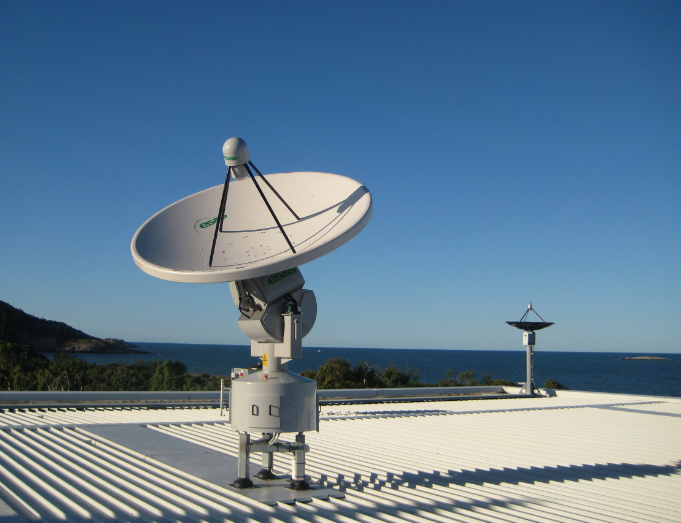
Phased Array Antennas
Introduction
Phased array antennas are a critical component in the domain of satellite communications. They are unique relative to other antenna arrays because they are capable of steering beams without any physical movement, which is enabled by multiple small antennas, or elements, with a phase shifter. This paper will explain the working mechanism of phased arrays by describing their advantages and provide the cost and benefit analysis to highlight their importance in modern communication systems.
Description.
The importance of a phased array mechanism is that such antenna systems are capable of beamforming, or steering the beam and realizing dynamic control of the antenna pattern. Specifically, the relative phases of the signal at each antenna element can be modified to enable the steering of the beam in other directions. This is essential for a variety of tasks, such as real-time satellite tracking or for a single antenna to maintain multiple links with other communication devices.
Cost efficiency and scalability.
The main disadvantage of using a phased array antenna is that it may seem more costly because of multiple elements and complex electronics. Thus, a simple phased array system can cost several thousand dollars, and the cost will keep increasing due to an exponentially larger number of elements and more advanced control with increased frequency and shifted phase. However, the advantages, such as continuous link maintenance regardless of whether between the attached systems will be justified in the long run . This is due to reduced mechanical wear compared to dishes that need to be adjusted to be focused by a satellite and lose accuracy in a course of time because they are unable to move .
Applications in modern communications.
In the 21st century, rapid beam switching and broad area coverage are necessary to facilitate the operation of a variety of information systems. Thus, the phased array antennas can be used in advanced 5-G networks and new radar systems. They are essential for mobile, such as ships and aircraft, medium because they are fast enough to maintain a satellite link while the system is moving across the sky.
Challenges and material planning.
The primary challenge associated with the phased array systems is heat, because any antenna element generates that type of pollution. The power required for the phased array mechanism can be noteworthy, as the system may need several kilowatts to function properly. Thus, the use of advanced materials and proper cooling is necessary to ensure that the full capacity of a robust communication system can be utilized in practice.
Flat Panel Antennas
Flat panel antennas are a leap forward in satellite communication technology that provides a new way of arranging compact, lightweight, and simple-to-mount gadgets instead of volumetric and massive dish antennas. These antennas utilize planar radiating elements with novel designs to give superior performance in a flat package.
Construction and Functionality
Flat panel antennas usually consist of an array of radiating elements placed in a thin layer of material. The implementation of this fronted-array technology results in electronic beam steering for fast and easy orientation of the antenna in space. As a result, tracking of the satellites is easy. Coupled with the low service requirements, this ensures an uninterrupted connection of the antenna with a mobile object. For example, these antennas can be installed on ships and planes.
Advantages Over the Traditional Models
Flat panel antennas show a number of advantages over dish antennas or other more traditional models. First, the flat profile and the fact that they are low profile devices is a significant advantage for objects on which they are installed. This could be such forms of vehicles as marine traffic, river transport, aircraft of any type, or buildings with architectural constraints. The absence of the need for heavy construction to install a dish dish for example is another benefit over the traditional alternatives.
Performance and Efficiency
The ability of flat panel antennas to track satellites in electronic style enjoys the very beneficial effect of keeping the beam locks through to a whole range of environmental extremes. For instance, regardless of temperature changes, high winds, and vibration splashes on marine traffic, the panel will maintain its connection to the satellite. Despite its size, the panel can achieve reasonable gain rates and the figure can often reach or even exceed the gain of dishes with all the related structure.
Cost
Flat panel antennas may appear costlier when they are initially implemented, in some cases even significantly costlier than traditional dish antennas. However, they demonstrate more cost-wise application throughout their lifetime due to the low cost of packaging and the resulting reduced propensity for maintenance. As the satellite flat panel assembly is solid state, it will have almost no maintenance requirements. Overall, the panel has a high scalability capacity that can be expanded by adding new features, for example, new beams and modules on different channels.
Horn Antennas
Horn antennas are among the most popular types of antennas used in satellite communications and radar systems. Flared in shape, horn antennas provide high directivity to electromagnetic waves and allow for effective radiation. Apart from their high gain, these antennas have a number of other benefits, including applications with microwave links, feeds for reflector systems, and radio astronomy.
Applications and Description
Horn antennas are effectively used in the transmission and reception of electromagnetic waves, and their shape allows for optimized efficiency. Flared design of horns provides a transition for electromagnetic energy from the transmission line to free space, leading to minimal losses and maximum radiation of signals. Made of brass, aluminum, or dielectric substrates, such as FEKO, horn antennas offer such characteristics as low loss. Unlike other types of antennas, such as reflector dish antennas, horn antennas can work effectively with high power without notable deterioration over time.
Performance & Directivity
One of the key applications of horn antennas is related to their high directivity. It can be assumed that horn antennas operate with a solid angle, which is several orders of magnitude smaller than omnidirectional antennas. In this sense, their gain is also more than 20 decibels. Horn antennas are used in satellite communications, and their ground station equipment incorporates both transmission and reception functions. Since they are more focused, they work more effectively in point-to-point communication. For example, they are used with satellite communication systems to focus and emit narrow beams from the earth and large areas on the satellite. Usually, a horn antenna used for a satellite has a gain of 25 to 30 decibels and its beamwidth can be no greater than a few degrees.
Advantages
The major benefit of horn antennas is their directivity, which is significantly higher than that of omnidirectional antennas. Thus, horns are mainly used whenever the distance covered by the signal is extended or a high level of radiation is necessary. Being widely used, horns are less likely to cause an interference problem in the media since they are more focused. The focus also eliminates the need for the same radiation power used by omnidirectional antennas. Malfunction of horns is less likely because they have fewer components than reflector dish antennas. In addition, since they are more broadband, they can operate reliably at a wide range of frequencies. A major lack of horn antennas is their physical size. At low frequencies, this can be particularly troublesome. The horns also have a wider sidelobe, making them more sensitive to interference when the bandwidth is crowded.
Helical Antennas
Introduction or Basic Information
Helical antennas represent a type of specialized antennas notable for their circular polarization and compact size. There are primarily two types of antennas characterized by the helical design and can be used for a variety of applications, ranging from satellite and radio astronomy to wireless telemetry systems. The antennas these types differ based on the characteristic of helical winding. The first type, called the helix antenna, is characterized by a common-mode helix, whereas the second type is based on a solenoidal form, which means the common-mode winding is tightened. The latter version is more commonly used, and the different types of helical antennas will be explored throughout this paper.
Signal Characteristics
The helical structure allows the antennas to generate circularly polarized electromagnetic waves. This type of signal is essential for a variety of communication scenarios because polarization is not decreased over prolonged travelling distances . Such polarization guarantees that the signal is not subject to fading or multipath propagation and, therefore, the link is always reliable . Satellites and satellite terminals, in general, are the devices that benefit the most from helical antennas. These structures are used for tracking satellites and controlling ground station equipment.
Advantages of Helical Antennas Over Traditional Antennas
Because of the small diameter of the helical antenna, it is rather difficult to distinguish it at first glance. This characteristic is in contrast to dish or horn antennas, which may have a significantly larger diameter and be distinguished from other devices. The most notable difference is that the performance is nearly the same, despite the helical antenna demanding less space. For example, in the case of satellite communication, which is one of the primary applications of helical antennas, the diameter of a particular antenna may vary, but more often than not, it rarely goes over several centimeters. Thus, these structures are used in portable satellite terminals, meaning aviation or maritime communication is often dependent on the helical antennas. What is more, the antenna’s small size does not mean the gain suffers. Instead, most helical antennas are relatively modest in the number of decibels at which they operate – ranging from 6-10 dBi. Wide bandwidth communication protocol enables transmission over a wide range of frequencies, although there will be some interference for extremely close frequency communications.
Reflectarray Antennas
Reflectarray antennas are types of antennas that have a planar array of elements to reflect an electromagnetic wave and achieve beamforming. These types of antennas are effective in various applications and can be flexible, low profile, and easily manufacturable. This paper describes these types of antennas, presents advantages over other types of antennas, performance, and efficiency, applications in communication and radar, as well as challenges, and future directions.
Innovative design elements
As was mentioned above, reflectarray antennas are a type of antennas that have an array of elements. In this case, each element can be controlled to be able to change the phase of the reflected signal. Phase control is possible either in real time or can be pre-programmed, and it is based on individual control of the radiation patterns of different elements . Therefore, phase control allows to steer a beam, change the shape of the beam, or cause deep nulls in a reflected signal.
Advantages over conventional antennas
Reflectarray antennas have numerous advantages over other types of antennas. For example, they are preferable as they have a low profile and are lightweight, which can be considered beneficial in mobile satellite terminals or UAV applications. Mobile satellite terminals continue to decrease and reach the size of a laptop. Reflectarray antennas should be compatible with these terminals. In addition, reflectarray antennas are discrete so preferable in UAV applications as they are not visible or not easily visible . Performance and efficiency
Reflectarray antennas can have a high performance in terms of gain, beamwidth, and efficiency . A good range of gains from 20 to 30 dB and beamwidths between a few degrees to one degree can be achieved. Although high gain is important for long-range communication links such as satellite communication and radar, narrow beamwidth is critical in terms of target isolation in both types of applications. reflectarrays, therefore, appear to be more beneficial than a conventional unshaped reflectarray at penetrating where higher spatial resolution of the target is required.
Applications in communication and radar
Reflectarray antennas can be used in various communication systems such as satellite communication, terrestrial point-to-point links, and networks. reflectarrays can be used to dynamically change the reflector’s radiation pattern required to keep a stable platform like satellite communication or track a moving target. reflectarrays can also be used in radar systems to detect targets, track their location or velocity, and help to estimate the location . challenges, and future directions
The most important problem is the bandwidth. The achievable bandwidth of the reflectarray is limited, and to maintain a good performance very wide bandwidth is still very challenging . Thus, further improvements and developments in reflectarray antennas require manufacturing technologies developments, signal processing algorithm developments, and materials.
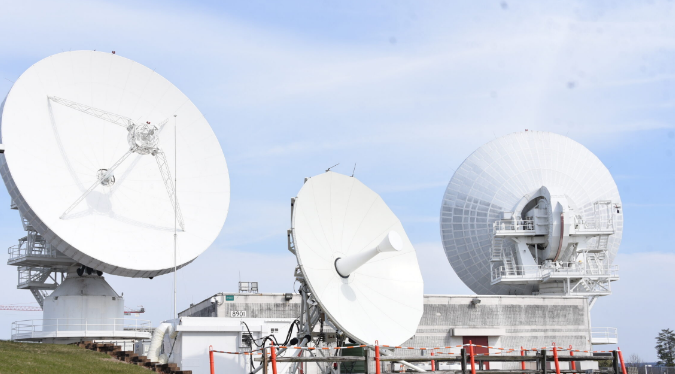
Omnidirectional Antennas
Omnidirectional antennas are antennas that radiate or receive electromagnetic waves at equal strength in all directions. The spherical radiation pattern defines this antenna type, and these antennas are commonly used where signal coverage on all sides is necessary. The applications of this type of antenna include broadcast radio, Wi-Fi hotspots, and mobile communication systems. Regarding the functional and features differences, the most important element is the ability to radiate or receive the signal at the same level of energy as opposed to a specified direction. Therefore, the radiation is omnidirectional in comparison to some antennas that focus their energy into a specified area .
There are several advantages of using them as opposed to the directional ones. First, the ability to provide coverage in all directions facilitates network planning and deployment, as there is the no necessity for careful orientation. Next, as some application requires high level of mobility as in cars and mobile devices the directional antennas need to be frequently reoriented. As for performance, the radiation pattern is three-dimensional and resembles a level of radiation in all directions around the antenna’s band perpendicular to the direction of each radius . This even distribution of radiation decreases the performance of the antenna in comparison to its counterparts.
Antennas have a gain of 0dBA up to 5dBA, and many factors can affect their performance, such as height, size, and weight of the antenna. Protection is determined by the frequency, and if it is higher, it can attain a lower gain than directed antennas. Omnidirectional antennas are used mainly in wireless communications including cellular networks, Wi-Fi hotspots, and Bluetooth gadgets_SOL1. In cellular networks, antenna is used in base stations to ensure coverage of the surrounding area. Similarly, Wi . Chellenges related to their utilization include interference and large radiation angles. Interference can be visualized below. During communication at the same frequency, the emitted signal overlaps with the nearby ones. An interference-free timeout is needed to avoid it. Also, the omnidirectional pattern of radiation can waste some of the radiation. For example, in the picture href=”photo_below.jpg” rel=”prettyPhoto” > there is a big loss of radiation on the road_SOL1!


